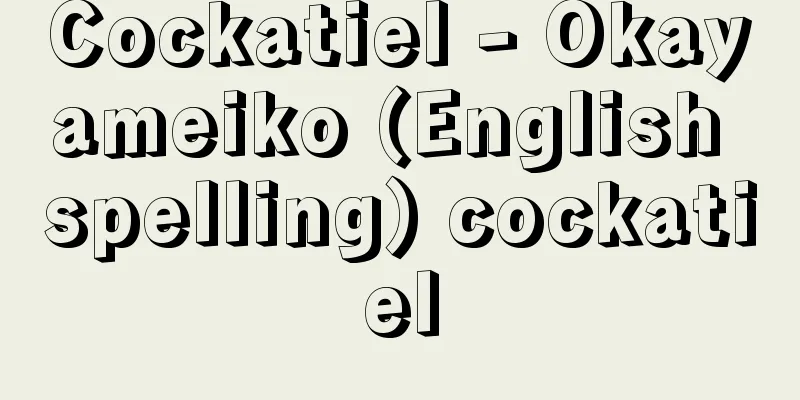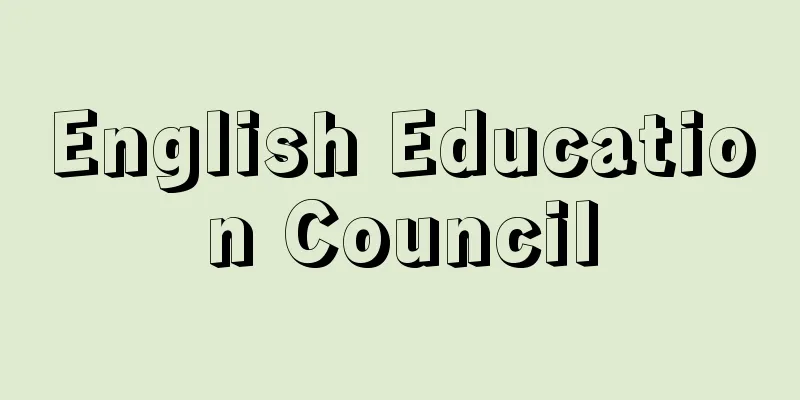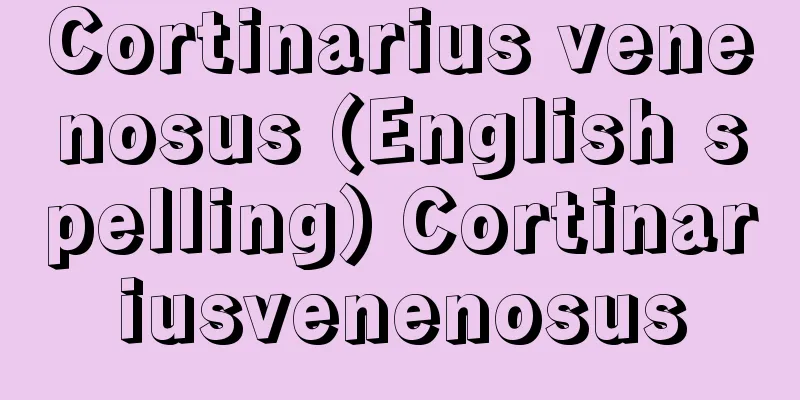Spanish Music

|
Since ancient times, Spaniards have had contact with people from Europe, Asia, Africa, and the Americas, and have influenced and been influenced by many different cultures. As a result, the country's music is rich in diversity, and its influence has reached countries around the world. When talking about Spanish music, it is difficult to completely separate art music from folk music, but for the sake of convenience, we will give an overview focusing on the art music trend. [Alvarez Jose] middle agesMedieval Spanish music before the Renaissance flourished from the time when liturgical music called Bishigothic chant or Mozarabic chant spread throughout Spain (5th to 8th centuries), with Seville in the south of the Iberian Peninsula, Toledo in the center, and Zaragoza in the north as its three poles. It is strange to call it "pseudo-Arabic (=Mozarabic) chant" in an era when the Goths from the north ruled the Iberian Peninsula, but this is the source of the diversity of Spanish music. In the 12th century, the Compostela School was born in Santiago de Compostela, a pilgrimage site in northern Spain. The Codex of Calisto is famous for conveying the music of that time, and it is said that this school also influenced the Notre Dame School in Paris. Meanwhile, the Codex of Las Huelgas, compiled in the 14th century, remains in Las Huelgas, Burgos, and among its works is the beautiful melody of Ave Maria, composed by Johannes Rodrigues (13th-14th century). The Scarlet Book of Montserrat, handed down in Montserrat, Catalonia, is also famous as a contemporary manuscript that includes secular music from the Catalan-speaking world. One notable compilation by a Spanish king is the Cantigas dell'Anna, named after Alfonso X the Wise (reigned 1252-1284), which contains over 400 Marian hymns. The lyrics are all written in Galician, which was the preferred language for verse at the time, and the poetic form shows influences from Arabic poetry. [Alvarez Jose] RenaissanceDuring the Renaissance, Spanish music, which had previously had a strong religious overtone, began to blossom in other areas. Many vocal pieces such as "villancico" and "romance" were composed in those days, as well as instrumental pieces such as "fantasia," "diferencia (variations)," and "tiento." The 15th-century Baribieri Songbook contains beautiful musical compositions by Juan del Encina (1468/1469-1529/1530), who was also famous as a poet and playwright, and the theorist Bartolomeo Romas de Pareja (c. 1440-after 1491/1521), who was also a contemporary. Composers active during this period included Juan de Anchieta (1462-1523), Francisco de Pañalosa (c. 1470-1528), Francisco de la Torre (active 1483-1504), and Alonso Pérez de Alba (?-1522). In the 16th century, Spain entered the Golden Age (Siglo de Oro), a period of political and cultural prosperity that produced many excellent musical works. Andalusian composers such as Cristóbal de Morales (c. 1500-1553) and Francisco Guerrero (1528-1599), Castilian composers Tomás Luis de Victoria (c. 1549-1611), Extremadura-born Juan Vásquez (c. 1500-after 1560), and Catalan composer Pedro Alberto Vila (1517-1582) left behind masterpieces in the villancico, cancionero, and romance genres. Among organ music, Antonio de Cabezón (c. 1510-1566) is particularly known for his Tiento, Diferencia, and Fantasia, which are important works from before Bach. Cabezón's pupil Fray Tomás de Santa María (c. 1510-1570) left behind beautiful keyboard music, such as in his Art of Playing Fantasia (published in 1565), and organist Francisco de Salinas (1513-1590) was also a prominent theorist. In the field of vihuela and guitar music, there are many great composers, including Juan Bermudo (c. 1510-c. 1565) from Sevillian; Enríquez de Valderrábano (c. 1500-c. 1557), who compiled the vihuela collection Silva de sirenas; Luis Milán (c. 1500-1561 onwards), who wrote El maestro; Miguel de Fuenllana (c. 1500-1579), who wrote Orfúnica lira; and Luis de Narváez (c. 1500-1579), who left us many beautiful divergences in the vihuela collection Delfín de música. The vihuela was also a highly accomplished composer, with vihuela players such as Narváez (c. 1500-1555) and Joan Carles Amat (1572-1642), who wrote a guitar textbook with chord charts that was revolutionary for the time, and it is no exaggeration to say that these "Differencias" were the most complete variations of the time. In addition, songs such as "Uppsala Lieder" and "Casa de Medinaceli Lieder" were composed in this period. [Alvarez Jose] 17th centuryThe tradition of church polyphony can be said to have been maintained in the 16th and 17th centuries by such composers as Joan Pau Pujol (c. 1573-1626) in Catalonia, Juan Bautista Comes (c. 1582-1643) in Valencia, Mateo Romero (1575-1647) known as "El Capitan" in Madrid, Carlos Patiño (1600-1675) in La Mancha, and Juan Marqués (1585-1658) in Catalonia. In this genre, we must not forget the activity of the Montserrat school, represented by Márquez, in the 17th century, which continued until the end of the 18th century. However, not all Spanish music of the time was produced by the Montserrat School, and the achievements of organists such as Francisco Correa de Arauxo (1584-1654) of Seville, José Ximénez (1601-1672) and Andrés de Sola (1634-1696) of Zaragoza, and Juan Cabanilles (1644-1712) of Valencia should also not be overlooked. In the 17th century, the Spanish operetta known as zarzuela was created by comedians and musicians who gathered at the Zarzuela Palace of King Philip IV (reigned 1621-1665). The plays of Lope de Vega and Calderón de la Barca were also accompanied by music. When people think of Spanish music, they often think of the guitar, and the person who laid the foundations of Spanish guitar music was Aragon-born Gaspar Sanz (mid-17th century - early 18th century). He wrote "Lessons in Guitar Music" and introduced many Spanish dances into guitar music. [Alvarez Jose] 18th centuryAt the beginning of this century, Spanish music went through a period of change. The guitar changed from five-course double strings to six-course single strings, and zarzuela began to decline. Foreign musicians, especially those from Italy, where Naples was a Spanish colony, such as D. Scarlatti and Boccherini, came to Spain, and it became a place for foreign musicians to flourish. Even during this period, the Catalan Domingo Terradellas (1713-1751) and the Valencian Vicente Martín y Soler (1754-1806) produced works that are said to have influenced Mozart's later operas. Antonio Soler Ramos (1729-1783) wrote many clavier sonatas and was also active as the conductor of the Escorial Palace. [Alvarez Jose] 19th centuryIn the 19th century, Spain was plagued by many political problems, including the invasion of Napoleon. Perhaps because of this, foreign music continued to flourish, but the revival of guitar music and zarzuela showed that Spanish music was still strong. Fernando Sor, who began his career at the end of the 18th century, and Dionisio Aguado (1784-1849), who came a little later, produced beautiful melodies on the six-string guitar. Their style was followed by José Brocá (1805-1882), Antonio Cano (1811-1897), José Viñas (1823-1888), Julián Arcas (1833-1882), and Juan Parga (1843-1899), who was from the north of the country and created guitar works that combined flamenco and Galician music in his own way. On the other hand, we cannot forget the genius Juan Crisóstomo Jacobo Antonio de Arriaga y Balzola (1806-1826), who was active abroad and was called the "Spanish Mozart" because he shared the same birthday as Arriaga and lived a short life. To revive zarzuela, Francisco Asenjo Barbieri (1823-1894) and others built the Zarzuela Theatre in Madrid in 1856. An important zarzuela composer was Emilio Arrieta (1823-1894), who was succeeded by Ruperto Chapí (1851-1909), Manuel Fernández Caballero (1835-1906), Federico Chueca (1846-1908), and others. Other people from this period include Felipe Pedrell (1841-1922) and Tomás Bretón (1850-1923), who attempted to create large-scale operas, as well as the world-famous violinist Sarasate and guitarist Tárrega. [Alvarez Jose] 20th centuryIn the 20th century, Albéniz and Granados inherited Pedrel's nationalist character. Both were known as pianists and had been active since the second half of the 19th century, but it was in the 20th century that Albéniz composed his masterpiece "Iberia" and Granados composed his masterpiece "Goyescas". Falla, known for his colorful style, as exemplified by the ballet music "The Three-Cornered Hat", learned Spanish music and colorful orchestration, and then began to express modern, non-representational beauty in his music. This inclination was inherited by Joaquín Turina (1882-1949), Joaquín Nin (1879-1949), Joaquín Rodrigo, and Xavier Montsalvatge (1912-2002), among others. On the other hand, composers who employ 20th century techniques include Robert Gerhard (1896-1970), who studied under Schoenberg, and his students Joaquim Homs (1906-2003), Cristóbal Halffter (1930-2021), and Luis de Pablo (1930-2021). What is particularly noteworthy about 20th century Spanish music is the number of renowned performers who are active worldwide, including cellists such as Casals and Casado, guitarists Segovia and Yepes, pianists Alicia de Larrocha and Rafael Orozco (1946-1996), conductor Rafael Frühbeck de Burgos (1933-2014), and vocalists Victoria de los Ángeles (1923-2005), Montserrat Caballé, Pilar Lorengar (1928-1996), Teresa Berganza, Alfredo Kraus (1927-1999), Plácido Domingo, and José Carreras. The interactions between Spaniards and other ethnic groups have also had a major influence on folk music. The country was once divided into several kingdoms, each with its own traditions, local color and dialects, and as a result, each region has left behind its own unique and excellent music. [Alvarez Jose] "History of Spanish Music" by G. Chase, translated by Kiyoe Tateno (1974, Zen-On Music Publishers)" ▽ "The Joy of Spanish Music - An Invitation to a Diverse World Woven by Temperament, Climate, and History" by Shigero Hamada, revised new edition (2012, Ongaku No Tomosha)" ▽ "Spanish Music" by J. Subira, translated by Shigero Hamada (Hakusuisha, Que sais-je Bunko)" ©Shogakukan "> Representative Spanish Folk Music by Region (… ©Shogakukan "> Representative Spanish Folk Music by Region (… Source: Shogakukan Encyclopedia Nipponica About Encyclopedia Nipponica Information | Legend |
|
スペイン人は、古くからヨーロッパはもとより、アジア、アフリカ、そしてアメリカ大陸の人々と交わり、さまざまな文化に影響を与え、また他国の文化の影響を受けてきた。したがって、音楽の面でも多様性に富み、その影響は世界各国に及んでいる。スペイン音楽について述べるとき、芸術音楽と民俗音楽とを完全に分けることはむずかしいが、ここでは便宜的に芸術音楽の流れを中心に概観する。 [アルバレス・ホセ] 中世ルネサンス以前の中世スペイン音楽は、イベリア半島南部のセビーリャ、中央部のトレド、北部のサラゴサを三つの極として、ビシゴート聖歌やモサラベ聖歌とよばれる典礼音楽がスペイン全体に行き渡った時代(5~8世紀)から花を開いた。北方系のゴート人がイベリア半島を支配していた時代に「偽(ぎ)アラビア(=モサラベ)聖歌」というのも不思議であるが、このあたりがスペイン音楽の多様性の源である。 12世紀に入ると、スペイン北部の巡礼地サンティアゴ・デ・コンポステラにコンポステラ楽派が生まれる。当時の音楽を伝えるものとしては『カリストの写本』が有名で、この楽派はパリのノートル・ダム楽派にも影響を与えたといわれている。一方、ブルゴスのラス・ウェルガスには14世紀に編まれた『ラス・ウェルガスの写本』が残されており、そのなかにあるホアン・ロドリゲスJohannes Rodrigues(ヨハネス・ロデリーチJohannes Roderici、13~14世紀)作曲の『アベ・マリア』などは美しい旋律で知られる。また、カタルーニャのモンセラートに伝わる『モンセラートの朱(あか)い本』は、カタロニア語圏の世俗音楽をも含む同時代の写本として有名である。スペインの王が編集したものとして注目されるのは、賢王アルフォンソ10世(在位1252~1284)の名が冠されている『聖母マリアのカンティガ集』であり、これには400余曲のマリア賛歌が収められている。歌詞は、すべて当時の韻文に好んで用いられたガリシア語で書かれており、詩型にはアラビア詩の影響がみられる。 [アルバレス・ホセ] ルネサンスルネサンス期に入ると、それまで宗教的色彩が強かったスペイン音楽は、その他の方面にも花開くことになる。当時のスペインでは「ビリャンシーコvillancico」や「ロマンセromance」といった声楽曲や、「ファンタシアfantasia」「ディフェレンシアdiferencia(変奏曲)」「ティエントtiento」といった器楽曲が多くつくられた。 15世紀の『バリビエリ歌集』には、詩人・劇作家としても有名なエンシーナJuan del Encina(1468/1469―1529/1530)の美しい音楽作品がみいだされるし、理論家ラモス・デ・パレハBartolomeo Romas de Pareja(1440ころ―1491以降/1521)も同時代の人物である。この時代に活躍した作曲家にはフアン・デ・アンチエタJuan de Anchieta(1462―1523)、フランシスコ・デ・ペニャロサFrancisco de Pañalosa(1470ころ―1528)、フランシスコ・デ・ラ・トーレFrancisco de la Torre(1483―1504活躍)、アロンソ・ペレス・デ・アルバAlonso Perez de Alba(?―1522)らがいる。 16世紀に入るとスペインは「黄金の世紀」(シグロ・デ・オロ)とよばれる時代に入り、政治・文化の両面でもっとも栄え、それに伴って音楽でも種々の優れた作品が世に出された。アンダルシア楽派のクリストバル・デ・モラーレスCristóbal de Morales(1500ころ―1553)、フランシスコ・ゲレロFrancisco Guerrero(1528―1599)、カスティーリャ楽派のトマス・ルイス・デ・ビクトリアTomás Luis de Victoria(1549ころ―1611)、エストレマドゥーラ地方出身のフアン・バスケスJuan Vasquez(1500ころ―1560以降)、カタルーニャ人のペドロ・アルベルト・ビラPedro Alberto Vila(1517―1582)らが、ビリャンシーコ、カンシオネロ、ロマンセなどの楽曲に名作を残している。オルガン音楽ではアントニオ・デ・カベソンAntonio de Cabezón(1510ころ―1566)の「ティエント」「ディフェレンシア」「ファンタシア」がバッハ以前のオルガン作品のなかでとくに重要である。カベソンの弟子でもあるフライ・トマス・デ・サンタ・マリアFray Tomás de Santa María(1510ころ―1570)はその『ファンタシアの演奏技法』(1565刊)などに美しい鍵盤(けんばん)楽曲を残しており、オルガン奏者フランシスコ・デ・サリーナスFrancisco de Salinas(1513―1590)は理論家としても優れた業績を残した。 ビウエラやギターの音楽では、セビーリャ出身のフアン・ベルムードJuan Bermudo(1510ころ―1565ころ)、ビウエラ曲集『シルバ・デ・シレナス』を編んだエンリケ・デ・バルデラバノEnríquez de Valderrábano(1500ころ―1557ころ)、『エル・マエストロ』を著したルイス・ミランLuis Milán(1500ころ―1561以降)、『オルフエニカ・リラ』を著したミゲル・デ・フエンリャーナMiguel de Fuenllana(1500ころ―1579)、ビウエラ曲集『デルフィン・デ・ムシカ』に多くの美しいディフェレンシアを残したルイス・デ・ナルバエスLuis de Narváez(1500―1555ころ)、当時としては画期的と思われるコード表つきギター教本を著したフアン・カルロス・アマートJoan Carles Amat(1572―1642)など、ビウエラ奏者=作曲家の活躍がすばらしく、これらの「ディフェレンシアス」は当時の変奏曲のなかでもっとも整った形をしていたといっても過言ではあるまい。また歌曲では、『ウプサラ歌曲集』『カサ・デ・メディナセリの歌曲集』などがこの時代に編まれている。 [アルバレス・ホセ] 17世紀教会の多声音楽の伝統は、16、17世紀には、カタルーニャのフアン・プホールJoan Pau Pujol(1573ころ―1626)、バレンシアのフアン・バウティスタ・コメスJuan Bautista Comes(1582ころ―1643)、マドリードの「エル・カピタン」ことマテオ・ロメロMateo Romero(1575―1647)、ラ・マンチャのカルロス・パティニョCarlos Patiño(1600―1675)、カタルーニャのフアン・マルケスJuan Marqués(1585―1658)らによって守られていたといえる。このジャンルでは、マルケスによって代表されるモンセラート楽派の17世紀における活躍を忘れてはならず、この楽派の活躍は18世紀末まで続く。しかし、当時のスペイン音楽のすべてがモンセラート楽派の手によるものであったわけではなく、セビーリャのフランシスコ・コレア・デ・アラウホFrancisco Correa de Arauxo(1584―1654)、サラゴサのホセ・ヒメネスJosé Ximénez(1601―1672)やアンドレス・デ・ソラAndrés de Sola(1634―1696)、バレンシアのフアン・カバニリェスJuan Cabanilles(1644―1712)らのオルガン奏者の活躍も見逃せない。 また17世紀には、フェリペ4世(在位1621~1665)のサルスエラ宮に集った喜劇役者や音楽家によって「サルスエラ」というスペイン風オペレッタがつくりあげられた。ロペ・デ・ベガやカルデロン・デ・ラ・バルカの劇作も音楽を伴うものであった。 スペイン音楽といえばギターを連想する人も多いが、そのスペイン・ギター作品の一つの基礎を築いたのが、アラゴン生まれのガスパル・サンスGaspar Sanz(17世紀なかば―18世紀はじめ)で、『ギター音楽教程』を著すとともに、多くのスペイン舞曲をギター音楽のなかに導入した。 [アルバレス・ホセ] 18世紀この世紀に入るとスペイン音楽は一つの転換期を迎える。ギターは5コース複弦から6コース単弦へと変化し、サルスエラは衰え始める。そして外国、とくにスペイン領ナポリのあったイタリアから、D・スカルラッティやボッケリーニらが訪れ、外国人音楽家の活躍の場となったが、この時期にあっても、カタルーニャのドミンゴ・テラデリャスDomingo Terradellas(1713―1751)、バレンシアのビセンテ・マルティン・イ・ソレルVicente Martín y Soler(1754―1806)らは、後のモーツァルトのオペラに影響を与えたといわれるほどの作品を残した。また、アントニオ・ソレル・ラモスAntonio Soler Ramos(1729―1783)は、多くのクラビア・ソナタを書き、エスコリアル宮の楽長としても活躍した。 [アルバレス・ホセ] 19世紀19世紀スペインは、ナポレオンの侵略その他の政治上の問題を多く抱えていた。そのためか、外国音楽の隆盛が続いたが、そのなかでスペイン音楽の健在を示したのは、ギター音楽とサルスエラの復興であった。 18世紀末から活動を始めたフェルナンド・ソルや、やや遅れて活動したディオニシオ・アグアドDionisio Aguado(1784―1849)は、6弦のギターで美しい旋律を生み出した。彼らの作風を受け継いだのが、ホセ・ブロカJosé Brocá(1805―1882)、アントニオ・カノAntonio Cano(1811―1897)、ホセ・ビニャスJosé Viñas(1823―1888)、フリアン・アルカスJulián Arcas(1833―1882)らであり、フラメンコとガリシアの音楽とを自己の内面で総合してギター作品をつくりあげた北部出身のフアン・パルガJuan Parga(1843―1899)であった。 一方、逆に外国で活躍し、誕生日が同じことと短命さのため「スペインのモーツァルト」とよばれた天才フアン・クリソストモ・ハコボ・アントニオ・デ・アリアガ・イ・バルソラJuan Crisóstomo Jacobo Antonio de Arriaga y Balzola(1806―1826)の存在も忘れられない。 サルスエラの復興にあたっては、フランシスコ・アセンホ・バルビエリFrancisco Asenjo Barbieri(1823―1894)らにより、1856年にサルスエラ劇場がマドリードに建設された。サルスエラの重要な作曲家にエミリオ・アリエタEmilio Arrieta(1823―1894)があり、それを受け継いでルペルト・チャピRuperto Chapí(1851―1909)、マヌエル・フェルナンデス・カバリェーロManuel Fernández Caballero(1835―1906)、フェデリコ・チュエカFederico Chueca(1846―1908)らが活躍した。 また、大規模なオペラの創作を試みたフェリペ・ペドゥレルFelipe Pedrell(1841―1922)やトマス・ブレトンTomás Bretón(1850―1923)、世界的に活躍したバイオリニストのサラサーテとギタリストのタレガも、この時代の人である。 [アルバレス・ホセ] 20世紀20世紀に入り、ペドゥレルの国民楽派的性格を受け継いだのは、アルベニスとグラナドスである。2人ともピアニストとして知られ、19世紀後半から活躍していたが、アルベニスが『イベリア』、グラナドスが『ゴイエスカス』という代表作を作曲したのは20世紀のことであった。バレエ音楽『三角帽子』を代表とする色彩的作風で知られるファリャは、スペイン固有の音楽や色彩的オーケストレーションを身につけたのち、現代的かつ非具象的な美を音楽のなかで表現するようになっていく。そしてこのような志向は、ホアキン・トゥリナJoaquín Turina(1882―1949)、ホアキン・ニンJoaquín Nin(1879―1949)、ホアキン・ロドリーゴ、ハビエル・モンサルバージュXavier Montsalvatge(1912―2002)らに受け継がれている。一方、20世紀的技法の作曲家としては、シェーンベルクに学んだロベルト・ヘラルドRobert Gerhard(1896―1970)、その弟子のホアキン・オムスJoaquim Homs(1906―2003)や、クリストバル・アルフテルCristóbal Halffter(1930―2021)、ルイス・デ・パブロLuis de Pablo(1930―2021)らが注目される。 20世紀のスペイン音楽で特筆すべきは、世界的に活躍する名演奏家を輩出していることであろう。チェロのカザルス、カサドをはじめ、ギターのセゴビア、イエペス、ピアノのアリシア・デ・ラローチャ、ラファエル・オロスコRefael Orozco(1946―1996)、指揮者のフリューベック・デ・ブルゴスRafael Frühbeck de Burgos(1933―2014)、声楽家ではビクトリア・デ・ロス・アンヘレスVictoria de los Ángeles(1923―2005)、モンセラット・カバリエ、ピラール・ローレンガーPilar Lorengar(1928―1996)、テレサ・ベルガンサ、アルフレド・クラウスAlfredo Kraus(1927―1999)、プラシド・ドミンゴ、ホセ・カレーラスら多士済々である。 なお民俗音楽でも、スペイン人と他民族とのかかわりが大きく影響しており、この国がかつていくつかの王国に分割され、それぞれ独自の伝統、地方色、方言をもっていることと相まって、各地に固有の優れた音楽を残している。 [アルバレス・ホセ] 『G・チェイス著、館野清恵訳『スペイン音楽史』(1974・全音楽譜出版社)』▽『浜田滋郎著『スペイン音楽のたのしみ――気質、風土、歴史が織り成す多彩な世界への"誘"い』改訂新版(2012・音楽之友社)』▽『J・スビラ著、浜田滋郎訳『スペイン音楽』(白水社・文庫クセジュ)』 ©Shogakukan"> 地方別にみたスペインの代表的民俗音楽(… ©Shogakukan"> 地方別にみたスペインの代表的民俗音楽(… 出典 小学館 日本大百科全書(ニッポニカ)日本大百科全書(ニッポニカ)について 情報 | 凡例 |
Recommend
Geranium erianthum (English spelling) Geranium erianthum
…[Mitsuko Shimizu]. … *Some of the terminology th...
Lime nitrogen - Sekkaichisso
It is a dark gray powder or small granule nitroge...
Ikasubaruseta, CG - Ikasubaruseta
… Research into Mesoamerican culture began with r...
Doppler effect
When a train passes in front of an observer stand...
Makromolekül (English spelling)
…Born in Worms, he received his doctorate from th...
velamen
…They are particularly abundant in tropical regio...
Four Heavenly Kings
It is a branch of Bunraku puppet theater, Kabuki K...
O'Brien, W.P.
…However, as with the pole vault, this would not ...
Hatano Kawakatsu
Year of birth: Unknown He was a close aide to Prin...
Muscari botryoides (English spelling) Muscaribotryoides
…[Yoshitaka Mizuno]. … *Some of the terminology t...
Agil Mangabey - Agil Mangabey
...Mangabey is the name of a region in Madagascar...
marginal nutrient deficiency
...It has also been said that large doses of asco...
Oshirobotok - Oshirobotok
...Faith in household gods (indoor gods) found in...
Hioki-so
A manor belonging to Miroku-ji Temple of Buzen Usa...
Ústí nad Labem
An industrial city that developed at the confluenc...









